Mastering Cost Risk with the CRED Model: A New Approach to Managing Uncertainty
Beyond the Spreadsheet: A Wake-Up Call for Estimation in Software Delivery
Trusted by leaders in the industry:
Trusted by leaders in the industry:
Software and IT organizations are facing an inflection point. Cost estimation, once viewed as a support function, now plays a central role in determining whether projects meet timelines, stay on budget, and contribute to business goals. But many teams are still relying on tools, workflows, and assumptions that were not built for the speed or complexity of today's environment. These outdated methods are not just inefficient. They are directly contributing to missed deadlines, budget overruns, and delivery failures.
Software and IT organizations are facing an inflection point. Cost estimation, once viewed as a support function, now plays a central role in determining whether projects meet timelines, stay on budget, and contribute to business goals. But many teams are still relying on tools, workflows, and assumptions that were not built for the speed or complexity of today's environment. These outdated methods are not just inefficient. They are directly contributing to missed deadlines, budget overruns, and delivery failures.
The survey results reflect a clear pattern. Estimation issues in software and IT are not isolated problems. They affect every stage of project planning and delivery, from early assumptions to final outcomes. The challenges are rooted in outdated tools, inconsistent processes, and a lack of strategic focus. The takeaways below highlight the most pressing issues reported by respondents across roles and organizations.
Key Takeaways
Budget overruns and missed timelines remain common across teams.
Confidence in estimation accuracy is low, with many still relying on static models that do not evolve with project data.
Alignment between engineering, finance, and program management is weak, leading to conflicting inputs and unclear accountability.
Automation and AI are underused, even though many teams see their potential to reduce rework and improve visibility.
Training and tool adoption continue to lag behind the complexity of modern estimation requirements.
Most organizations do not capture post-project learning, which leads to repeated estimation mistakes across delivery cycles.
Improving estimation does not require a full rebuild, but it does require a clear shift in how it is prioritized and supported. Estimation is no longer a side task. It is a core planning function that affects every major decision tied to cost, schedule, and delivery. Organizations that continue to rely on outdated tools and fragmented workflows are not just creating inefficiencies. They are increasing the risk of failure.
Now is the time to act. Leaders should focus on the fundamentals: connect estimation models across teams, integrate real-time data, automate low-value tasks, and invest in training that reflects current demands. These are not optional enhancements. They are prerequisites for producing accurate, timely, and defensible forecasts.
Spreadsheets and disconnected templates can no longer meet the complexity of modern software and IT projects. Estimation must evolve to include real-time connections to execution tools, built-in compliance logic, and the ability to simulate scenarios based on shifting requirements. The longer teams wait, the harder it becomes to close the gap between outdated practices and modern expectations.
This report provides a roadmap for moving forward. It highlights where teams are falling behind, where progress can be made quickly, and what a high-performing estimation function looks like. The message is clear. Estimation shapes outcomes. Organizations that treat it as a business-critical capability will lead. Those that ignore it will continue to fall short.
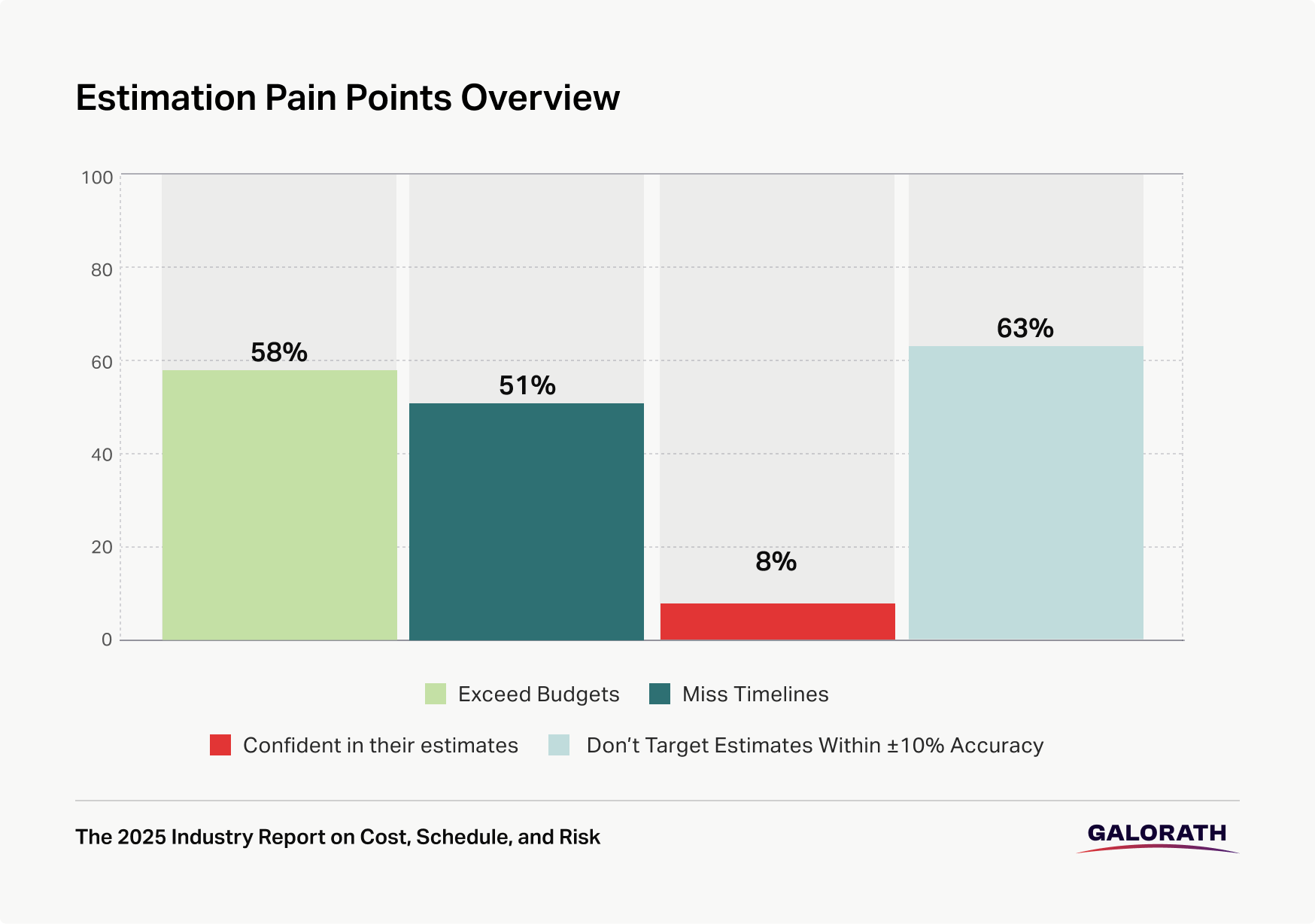

Software and IT teams continue to struggle with cost and schedule reliability. Agile methods and iterative planning have not solved the core issues. Many organizations still face repeated overruns, delayed releases, and low confidence in their forecasts. These are not isolated missteps. They are symptoms of deeper, systemic failures in how estimation is handled across teams.
Fifty-eight percent of respondents say projects exceed budget occasionally, and 51% report frequent or very frequent timeline overruns. Only 8% feel very confident in their estimates, and just 44% aim to stay within 10% of actuals. These figures point to estimation practices that lack both consistency and credibility.
What Metrics Are Being Tracked?
0%
say they exceed budgets
0%
say they miss timelines
One of the most damaging gaps is the lack of integration between estimation and real-world feedback. Fewer than half of respondents update their models quarterly, and only 33% conduct performance reviews more than once per quarter. This broken feedback loop makes it difficult to correct errors, reinforce accountability, or adapt forecasts to evolving conditions.
Only 4% of manufacturers have automated more than 75% of their estimation process. Another 65% have partially automated between one quarter and one half of their workflows. That leaves most teams stuck with semi-manual processes that limit productivity and increase exposure to error.
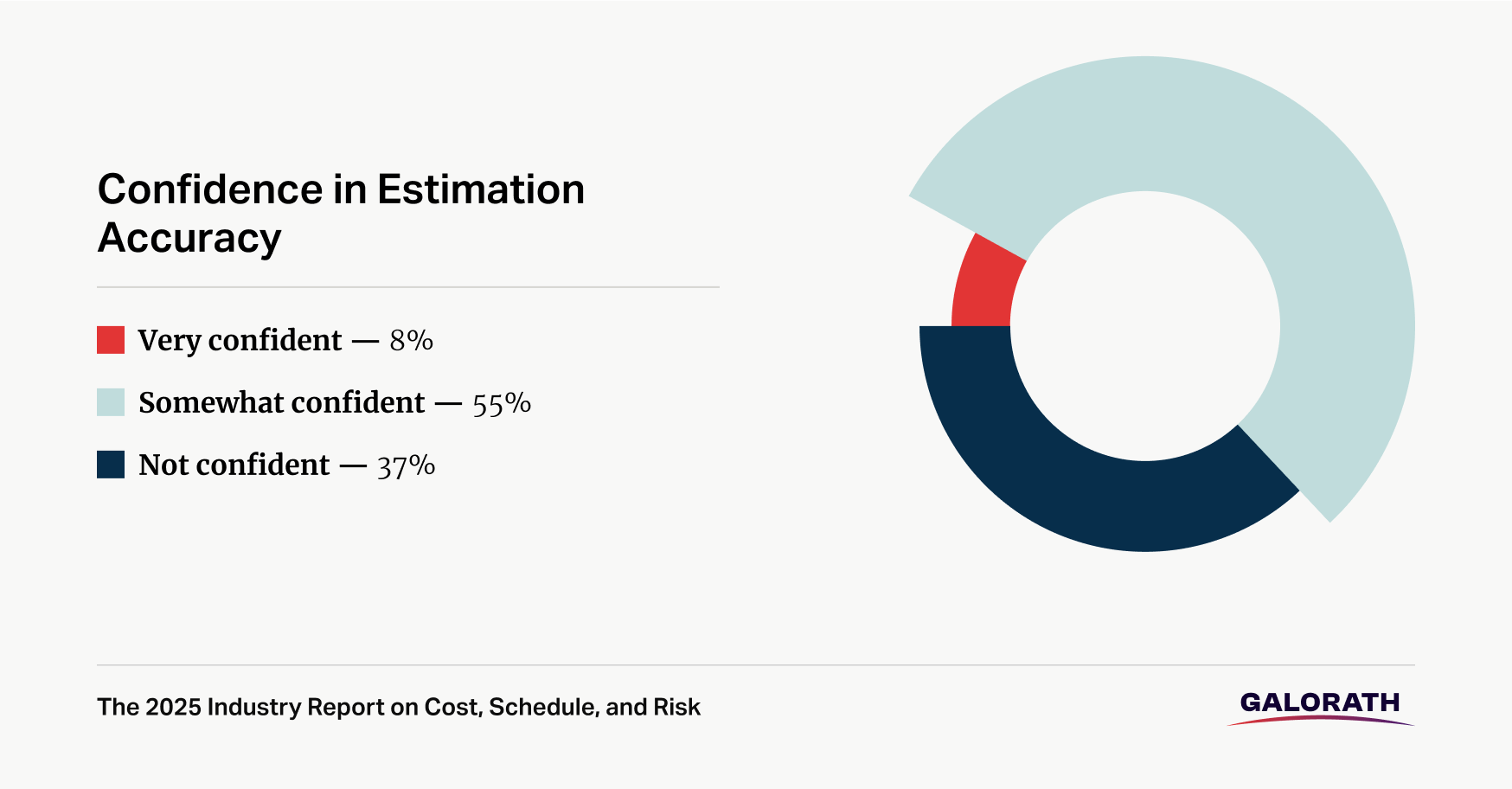
The risks go beyond tool selection. Many teams continue to anchor their forecasts to outdated assumptions, disconnected inputs, and static models that do not reflect actual project behavior. Estimates are often built on incomplete data, subject to conflicting stakeholder opinions, and delivered too late to influence decisions. These gaps do not just slow teams down. They lead to misaligned tradeoffs, poor resource planning, and reduced responsiveness when priorities shift.
Until estimation is treated as a shared responsibility with real business impact, these risks will persist. The cost is not just in missed targets. It is in lost trust, wasted effort, and preventable failure.
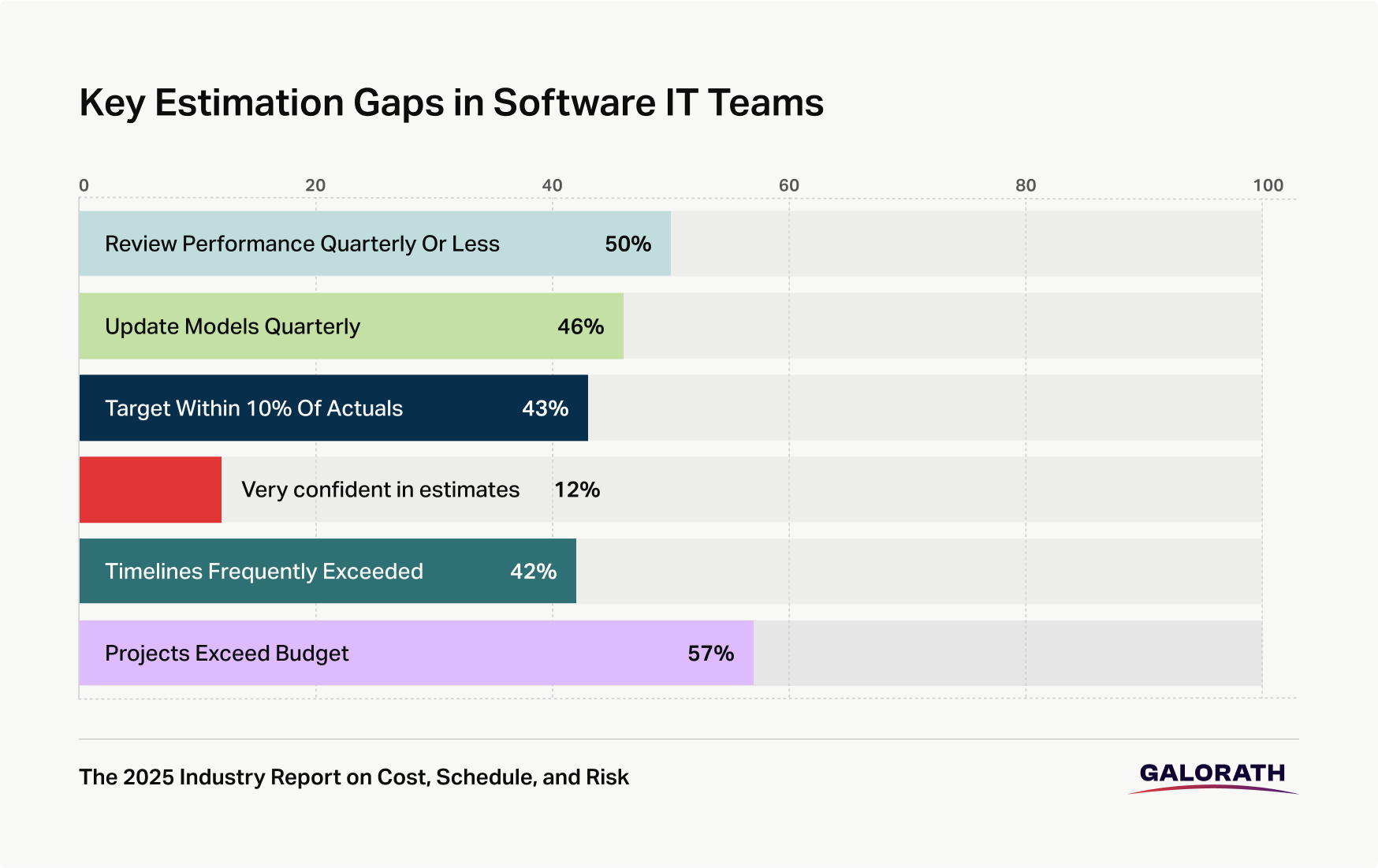
To improve estimation performance & reduce downstream disruption, teams should:
Shift from static models to rolling updates with real-world data
Introduce performance tracking at project close to validate assumptions
Assign shared accountability across engineering, finance, & PMO
When feedback becomes part of the planning process, estimation moves from reactive guesswork to a more trusted business function.

Cost estimation in software is not just a technical exercise. It is a coordination challenge across teams that define success differently, rely on separate data, and operate on disconnected timelines.
The survey shows that 77% of respondents define success by time to completion, and 70% focus on cost adherence. But only 35% include alignment between teams in their success criteria, revealing a critical gap. Without cross-functional cohesion, teams may hit deadlines and budgets but still miss broader expectations.
What Defines Estimation Success?
0%
On time
0%
On budget
0%
Aligned with broader objectives
Just 33% of respondents report full integration of estimation across departments. In most organizations, engineering, finance, and project teams still use different tools and assumptions. This fragmentation creates avoidable errors and makes it difficult to trace whether failures stem from bad execution or flawed planning.
Open-ended feedback reinforces this point. Respondents frequently cited:
Unclear ownership of estimation responsibilities
Lack of transparency in how assumptions are shared or updated
Frequent changes in input data without a clear process for reconciliation
Misalignment erodes trust. When teams are not working from the same baseline, delays, rework, and second-guessing follow.
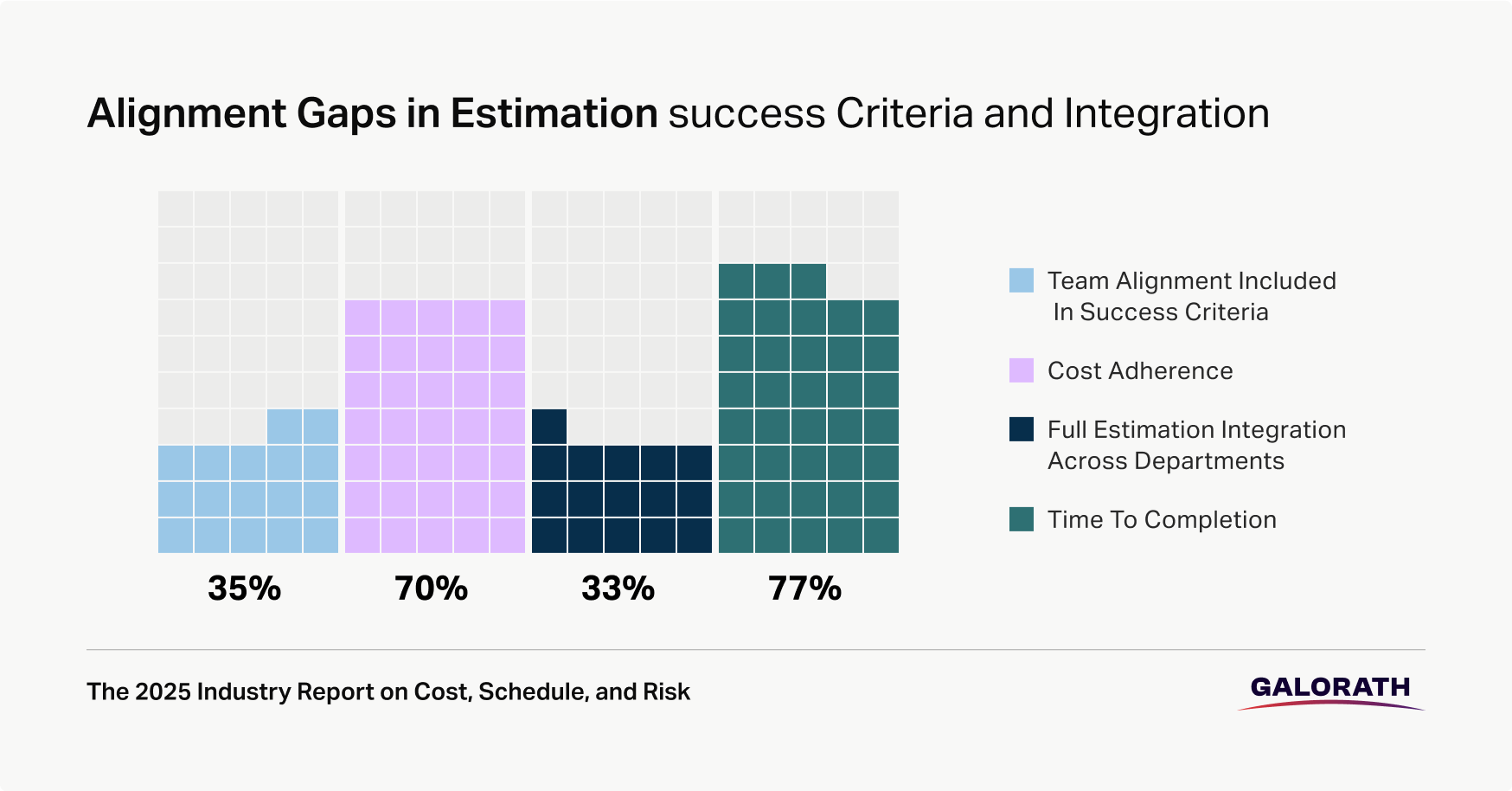
To close the alignment gap, organizations should:
Establish shared KPIs for scope, cost, and delivery across roles
Standardize estimation models with agreed assumptions and inputs
Create review checkpoints that include engineering, finance, and delivery leaders
Estimation should reflect how the business operates. When teams plan together, they can execute with greater clarity and fewer surprises.

Artificial intelligence continues to dominate enterprise strategy, but most software and IT estimation teams are not yet benefiting from its potential. Nearly half of respondents say their organizations are not using any AI tools in their estimation workflows. Despite growing awareness, adoption remains stalled.

Only 5% of respondents have automated more than 75% of their estimates, and most remain below 50%. This heavy dependence on manual methods slows analysis, increases rework, and limits the ability to scale across fast-moving or resource-constrained programs. As projects grow more complex, the absence of automation becomes a direct threat to efficiency and cost control.
The urgency is clear. When asked what improvements would have the greatest impact, 72% of respondents cited automation of repetitive tasks, and 65% prioritized real-time data integration. Teams know where support is needed, but progress is blocked by disconnected systems, limited training, and a lack of operational use cases.
Only 25% say AI is very important to their current workflows. That figure signals a deeper readiness gap. The problem is not lack of interest. It is a failure to build the foundation required to act. Organizations that continue to delay investment will struggle to compete with those that can forecast faster, adjust sooner, and control costs with greater precision.
In a field where timelines are tight and margins are thin, automation is no longer a future consideration. It is a present requirement. The gap between manual workflows and scalable, intelligent estimation is quickly becoming a competitive divide.
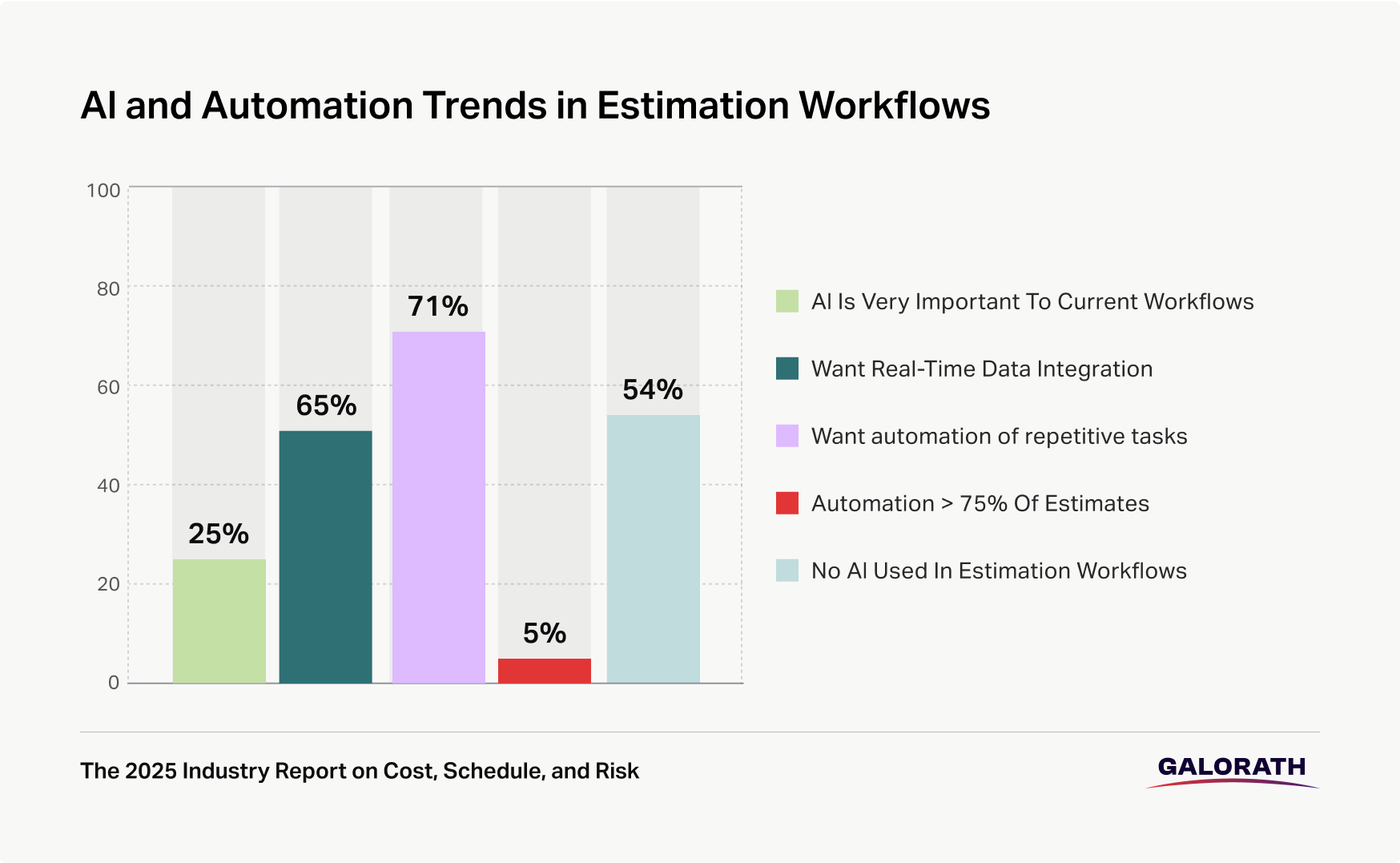
To make AI useful in estimation, organizations should:
Start small with automation of high-volume, low-complexity tasks
Use historical project data to generate cost benchmarks and trend flags
Align IT and estimation teams to identify scalable integration opportunities
AI is not a silver bullet. But when paired with better inputs and connected systems, it becomes a practical accelerator for faster, more reliable estimation.

Software estimation is under pressure, and most teams are not equipped to handle it. Seventy-nine percent of respondents still rely on Excel, a tool not designed for traceability, collaboration, or the demands of modern project delivery. Even with added dashboards or plugins, spreadsheets remain a major source of risk. They limit visibility, fragment knowledge, and slow down decision-making.
The solution is not out of reach. Estimation-specific platforms like SEER®, TruePlanning®, and others are available, but adoption remains minimal. Across all estimation-focused tools in the dataset, usage totals just 64%. These platforms offer structured models, automation, and repeatability, all features that spreadsheets can’t match.
The real issue is not technology. It is a lack of organizational commitment
Only 32% of respondents say their teams receive structured training. At the same time, 30% cite capability gaps as a major barrier. This disconnect is costly. Teams are expected to produce faster, more accurate forecasts without the tools, knowledge, or frameworks to succeed.
Skipping training is not a neutral decision. It results in preventable rework, missed deadlines, and planning cycles that stall before execution begins. The impact is not theoretical. Respondents identified hands-on learning, like online courses and in-person workshops, as the most effective way to improve performance. These formats help close the gap between senior and junior team members and build lasting capability across the organization.
When teams lack training and support, estimation becomes guesswork. And when guesswork drives project planning, the risk of failure increases with every cycle.
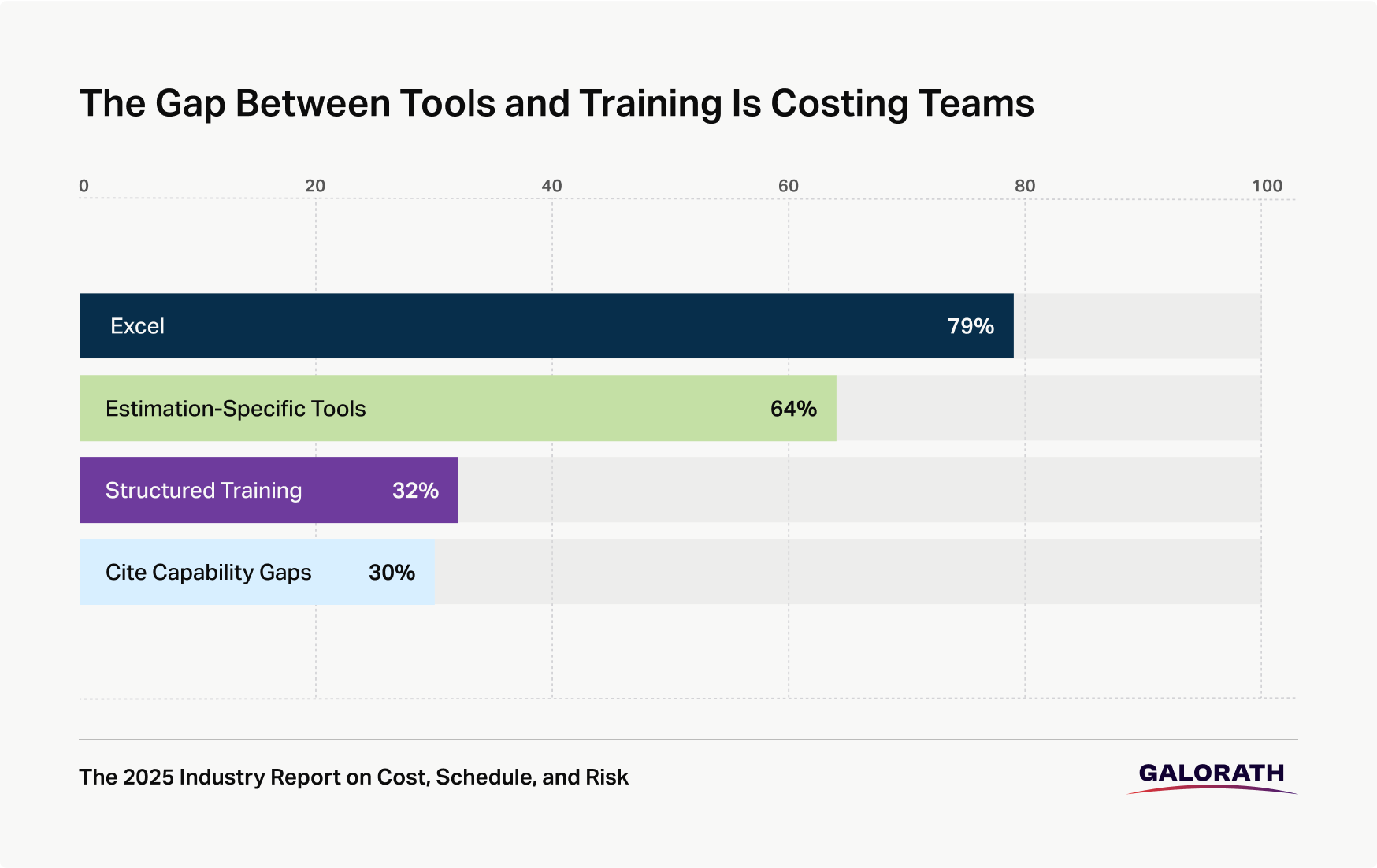
To improve capability and reduce tooling friction, organizations should:
Evaluate current tool usage and phase out unsupported or manual methods
Pair software rollouts with structured onboarding and real-world use cases
Build internal champions or centers of excellence to support consistency
Use learning platforms to track adoption and identify areas for reinforcement
Investing in people and systems at the same time makes the process repeatable. Over time, this leads to faster estimates, fewer surprises, and stronger project delivery.

Estimation is no longer a background task. It is becoming a strategic capability with growing influence on portfolio planning, regulatory compliance, capital forecasting, and organizational trust. According to the data, 42% of respondents say estimation is extremely important to four-year planning, and 67% say regulatory requirements shape their approach at least moderately.
Despite this shift, most organizations are still missing key opportunities. 73% actively use historical project data, and 71% use engineering estimates to inform cost models. These inputs should be baseline components of the estimation process, not optional references.
The path forward does not require a complete overhaul. It requires building estimation maturity in a way that aligns with how software teams actually operate.
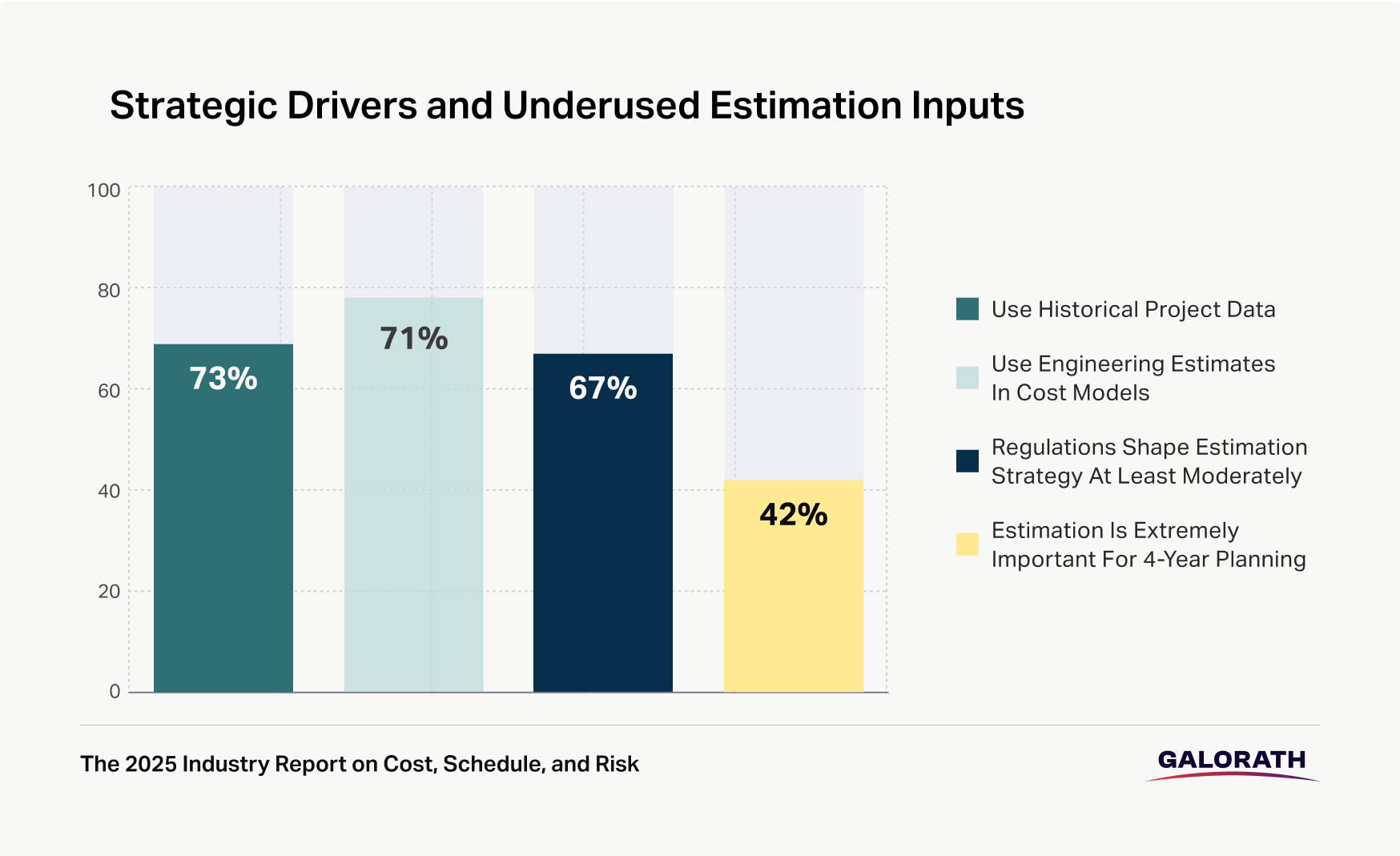

To drive change, each team must engage with estimation in a clear, actionable way.
Engineering Leaders
Use structured tools for simulation and modeling. Keep estimates current and review them after each milestone.
Program Managers
Link delivery metrics to estimation accuracy. Use post-project analysis to improve planning cycles.
Finance Teams
Align forecast granularity with capital planning needs. Use estimation tools that connect to enterprise financial systems.
IT and CIOs
Integrate estimation platforms with ERP, PLM, & project tracking systems. Prioritize data accessibility & version control.
Estimation is no longer just about predicting costs. It is about equipping teams with the clarity, coordination, and confidence to plan, adapt, and deliver. The findings in this report show that while the challenges are real, tooling gaps, delayed feedback, and fragmented inputs are also solvable. With focused action across systems, training, and cross-functional alignment, software and IT organizations can shift estimation from a recurring risk into a measurable advantage. The next phase of maturity starts not with perfection, but with progress.
This report is part of a deeper look at how cost, schedule, and risk planning are evolving. Access the full 2025 Industry Report on Cost, Schedule, and Risk to see where the biggest gaps and opportunities exist.
Access The Report